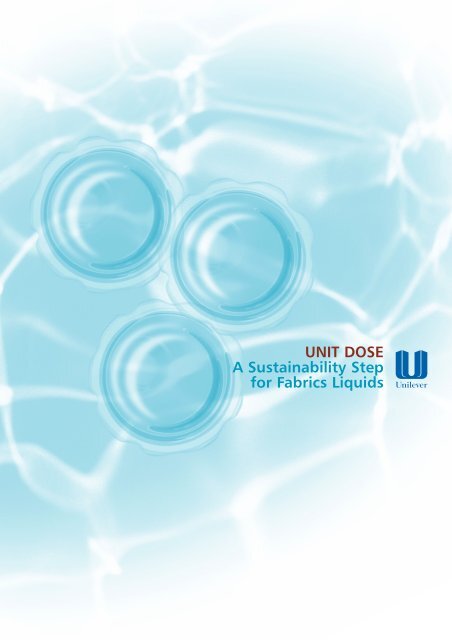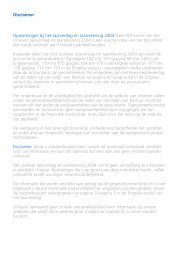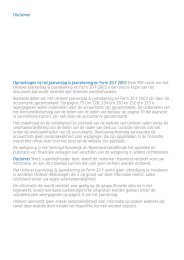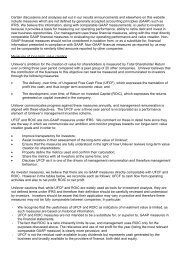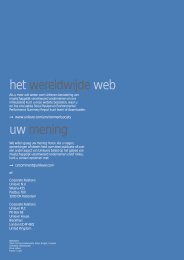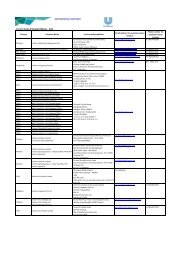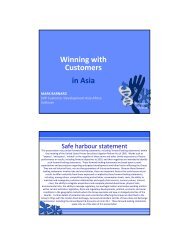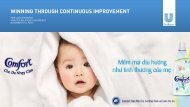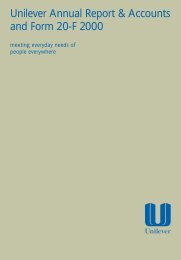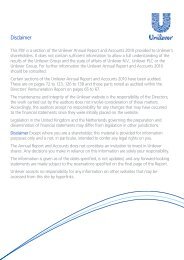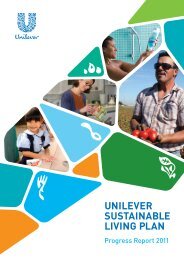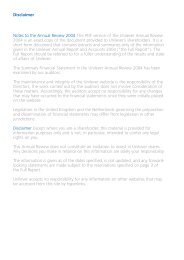Unit Dose - A Sustainability Step for Fabrics Liquids - Unilever
Unit Dose - A Sustainability Step for Fabrics Liquids - Unilever
Unit Dose - A Sustainability Step for Fabrics Liquids - Unilever
You also want an ePaper? Increase the reach of your titles
YUMPU automatically turns print PDFs into web optimized ePapers that Google loves.
UNIT DOSE<br />
A <strong>Sustainability</strong> <strong>Step</strong><br />
<strong>for</strong> <strong>Fabrics</strong> <strong>Liquids</strong>
<strong>Unilever</strong> Supports Sustainable Development of Detergents with Capsules<br />
<strong>Unilever</strong> is committed to<br />
meeting the needs of<br />
customers and consumers<br />
in an environmentally<br />
sound and sustainable<br />
manner, through<br />
continuous improvement in<br />
environmental per<strong>for</strong>mance<br />
in all our activities.<br />
A SUSTAINABILITY STEP<br />
FOR FABRICS LIQUIDS<br />
CAPSULES – UNIT DOSE<br />
Product innovation has been one of<br />
the major influences in reducing the<br />
environmental impact of laundry<br />
detergent. Sustainable consumption of<br />
detergents has been promoted by linking<br />
it to other benefits which consumers<br />
find more important. <strong>Unit</strong> dose can do<br />
that by:-<br />
• Offering the consumer “just add two”<br />
convenience.<br />
• Reducing usage by avoiding “that little<br />
bit extra”.<br />
<strong>Fabrics</strong> washing tablets, first widely<br />
introduced by <strong>Unilever</strong>, do this and<br />
the sector has shown steady growth<br />
within Western Europe as all major<br />
brands have introduced tablets.<br />
14%<br />
12%<br />
10%<br />
8%<br />
6%<br />
4%<br />
2%<br />
0%<br />
TABLETS VALUE % OF FABRICS<br />
SOLUTION WASH<br />
1997 1998 1999 2000<br />
Tablets have already produced an<br />
Industry environmental saving of over<br />
250,000 tonnes of product per year.<br />
<strong>Unit</strong> dose capsules now offer this same<br />
win-win combination in liquids <strong>for</strong>m.<br />
Although liquids have a much smaller<br />
market share than solid detergents<br />
(powders plus tablets) capsules will now<br />
enable consumers to wash more<br />
sustainably with liquids too.
THIRTY YEARS AGO<br />
<br />
Washing used twice as<br />
much water and more than<br />
three times as much detergent<br />
as it does today.<br />
We soaked 20% of<br />
wash-loads, compared with<br />
2% now.<br />
The average wash<br />
temperature was 65°C, now<br />
it is 45°C.<br />
4 out of 10 washes were<br />
boil washed; now it’s 1 in 10.<br />
<br />
<br />
<br />
*AISE: Association Internationale<br />
de la Savonnerie, de la Détergence<br />
et des Produits d’Entretien<br />
DETERGENT CONSUMPTION<br />
Capsule users typically dose 50g of<br />
product. Thus capsules provide a<br />
reduction in product usage compared<br />
with habits dosage <strong>for</strong> other <strong>for</strong>mats in<br />
almost all countries.<br />
DETERGENT CONSUMPTION PER WASH<br />
Habits dosage g/wash<br />
200<br />
150<br />
100<br />
50<br />
0<br />
If liquids unit dose achieves the same<br />
sector penetration as tablets have, the<br />
Industry will reduce environmental<br />
loading by a further 50,000 tonnes of<br />
product per annum.<br />
••••CAPSULES••••CAPSULES••••CAPSULES••••CAPSULES••••CAPSULES••••CAPSULES••••CAPSULES••••CAPSULES••••<br />
UK IRE NL FR<br />
Tablets Conc Pdr Std Pdr Conc Liq Std Liq<br />
LIFE CYCLE ASSESSMENT<br />
As with most detergent products, the<br />
main impact of liquids is in the use phase<br />
and results from the energy needed to<br />
heat water. The detergent industry and<br />
machine manufacturers are working<br />
together to reduce this impact. More<br />
sustainable consumption means<br />
encouraging consumers to use the correct<br />
(usually lower) product dosage, choose<br />
the correct wash cycle and not wash part<br />
loads. All of these are highlighted by the<br />
AISE’s * Washright campaign.<br />
N/A<br />
The nutrification potential impacts the<br />
disposal stage but is reduced by lower<br />
product dosages. It is a direct result of the<br />
emission of the organic components of the<br />
product entering the sewage system after<br />
use. In the absence of sewage treatment<br />
this would feed the growth of algae and<br />
other life <strong>for</strong>ms. However, this nutrient<br />
contribution is small compared to the total<br />
nutrient loading on the environment,<br />
which includes the contribution of<br />
agricultural, human and industrial waste as<br />
the most dominant <strong>for</strong>ms.
ENVIRONMENTAL INDICATORS<br />
USED IN LCA<br />
Global Warming Potential:<br />
emissions of greenhouse gases are<br />
leading to an increased absorption<br />
of radiation emitted by the earth<br />
resulting in global warming.<br />
Contributing emissions include<br />
carbon dioxide, methane and<br />
nitrous oxide and are expressed in<br />
terms of carbon dioxide<br />
equivalence.<br />
Acidification Potential: acid<br />
deposition on soil and water can<br />
lead to detrimental effects on both<br />
flora and fauna. The acidifying<br />
emissions are the oxides of sulphur<br />
and nitrogen oxides that result<br />
from combustion processes.<br />
Photochemical Oxidant Creation<br />
Potential: low-level smog is <strong>for</strong>med<br />
by the reaction of nitrogen oxides<br />
and volatile organic compounds<br />
(VOCs) under the influence of UV<br />
light. Contributing emission<br />
sources include the manufacture of<br />
plastic packaging materials and the<br />
combustion of natural gas.<br />
Nutrification Potential:<br />
the emission of nutrients can lead<br />
to increases in biomass production.<br />
In water, this can lead to algal<br />
blooms resulting in oxygen<br />
depletion that affects higher<br />
species such as fish. Undesirable<br />
shifts in numbers of species can<br />
also occur, resulting in a threat to<br />
biodiversity. Contributing<br />
emissions from the detergent life<br />
cycle are phosphate and<br />
biodegradable materials.<br />
Solid Waste: the sum of all the<br />
sources of solid waste over the<br />
product life cycle. The primary<br />
sources are from mineral-based<br />
raw material sourcing, solid fuel<br />
combustion and packaging<br />
materials.<br />
Energy: the total amount of<br />
primary fuel reserves extracted<br />
from the earth taking into account<br />
the efficiency of electricity<br />
generation and heat producing<br />
processes. This indicator is a basic<br />
measure of resource depletion but<br />
is useful because other indicators<br />
are related to energy.<br />
The examination of the energy<br />
profile can provide valuable<br />
insights into environmental<br />
per<strong>for</strong>mance in general.<br />
<strong>Unilever</strong> Supports Sustainable Development of Detergents with Capsules<br />
TYPICAL IMPACT OF FABRICS WASHING LIQUID BY LIFE CYCLE STAGE (UK data)<br />
Ingredients<br />
Packaging<br />
Comparison with the major laundry<br />
detergent <strong>for</strong>mats in the countries where<br />
we already have capsules, shows that a shift<br />
to capsules generates improvements across<br />
several environmental per<strong>for</strong>mance<br />
indicators. The figures are calculated <strong>for</strong><br />
habits dosages <strong>for</strong> the ‘old’ <strong>for</strong>mats.<br />
These results demonstrate the<br />
environmental advantage <strong>for</strong> capsules<br />
over liquids in <strong>Unilever</strong>’s lead roll out<br />
countries.<br />
Production<br />
Transport<br />
LCA COMPARISON OF UNIT DOSE CAPSULES AND OTHER FORMATS<br />
Use<br />
Disposal<br />
Lever Fabergé Capsules Global Acidification Photochemical Nutrification Solid Waste Energy<br />
vs Other Formats Warming Potential Oxidant Creation Potential<br />
Potential Potential<br />
UK (Liquid)<br />
France (Liquid)*<br />
Netherlands (Liquid)<br />
UK (Std Pdrs)<br />
France (Std Pdrs)<br />
Netherlands (Conc Pdrs)<br />
UK (Tablets)<br />
GWP<br />
Acidification<br />
Potential<br />
POCP<br />
Nutrification<br />
Potential<br />
Solid Waste<br />
Energy<br />
France (Tablets)<br />
Netherlands (Tablets)<br />
0% 20% 40% 60% 80% 100%<br />
* Both standard and concentrated <strong>for</strong>mats<br />
Also, capsules’ environmental position is<br />
generally better than, or at least equal to,<br />
powders and tablets.<br />
Of course, capsules only offer liquids<br />
(bleach-free) per<strong>for</strong>mance levels and this<br />
level of cleaning will not be adequate <strong>for</strong><br />
all users of heavy duty, bleach-containing<br />
powders. However, we do expect many<br />
powders users to be satisfied with the<br />
level of cleaning offered by capsules and<br />
to make the change.<br />
Significant Improvement Significant Worsening No Change
<strong>Unilever</strong> Supports Sustainable Development of Detergents with Capsules<br />
PACKAGING CONSUMPTION<br />
<strong>Unilever</strong> considers its use of packaging<br />
very carefully to satisfy the demands of<br />
consumers and trade customers, ensure<br />
appropriate presentation on shelf and<br />
meet the needs of national and<br />
international distribution.<br />
Packaging is an integral part of the<br />
product and the consumers’ first point of<br />
contact with the brand. It helps protect<br />
the product from damage, contamination<br />
and deterioration during storage. It has<br />
to be aesthetically pleasing and provide<br />
marketing in<strong>for</strong>mation. It must take into<br />
account consumer safety and provide all<br />
necessary safety instructions. In some<br />
cases, the packaging helps the consumer<br />
use the product efficiently. In short it<br />
must be safe, functional and attractive<br />
but minimise environmental impact<br />
consistent with these objectives.<br />
Achieving this balance is complex but<br />
important.<br />
Our policy is to:<br />
• Design packaging to do its job with<br />
the lowest practical use of materials<br />
• Select packaging materials on<br />
technical per<strong>for</strong>mance evidence<br />
• Design packaging to ease recycling<br />
and energy reclamation<br />
Capsules are very sensitive to moisture<br />
and damage, hence they place rigorous<br />
demands on the packaging system. It is<br />
essential to maintain product quality and<br />
integrity – a single leak can cause a mess<br />
and product wastage. This is why<br />
capsules need more packaging per wash<br />
than tablets, concentrated powders and<br />
concentrated liquids (ca 20-40%).<br />
However, as capsules are concentrated,<br />
they use less packaging than standard<br />
powders and liquids (15-70%). Of<br />
course they are new products and as with<br />
any new or existing packs, we are<br />
constantly looking <strong>for</strong> opportunities to<br />
further optimise packaging weight.<br />
In addition to ensuring the minimum<br />
amount of packaging <strong>for</strong> purpose is used,<br />
the packaging is fully recoverable. It can<br />
either be recycled or safely incinerated<br />
with energy recovery (the route<br />
depending on local conditions).<br />
CODE OF GOOD ENVIRONMENTAL PRACTICE<br />
The introduction of capsules will<br />
contribute to achieving the<br />
AISE’s “COGEP” targets.<br />
The saving in chemicals<br />
per wash will approach 2% in<br />
2001 with a similar reduction in poorly<br />
biodegradable materials of 1.8%.<br />
www.washright.com
Printed on Recycled Paper<br />
For further in<strong>for</strong>mation on capsules, email us at capsules@unilever.com<br />
For further in<strong>for</strong>mation on <strong>Unilever</strong>, visit us at www.unilever.com<br />
Published September 2001 Prepared and issued by <strong>Unilever</strong> HPC – Europe


